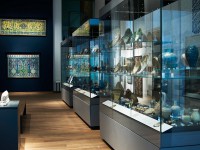Room 31 | Islamic Middle East gallery
Explore artefacts made over a period of more than 1000 years in the heart of the Islamic world.

‘The people of China are the most skilful of Allah's creation, in designing and fabricating and all other types of work. They are not surpassed in this.'
(From the account on China and India by Abu Zaid Hasan ibn Yazid al-Sirafi, second half of the 800s-early 900s AD)
In the late AD 700s, trading contacts with China resulted in the import of large quantities of high-fired white wares to the Islamic world. These probably came as ballast in ships carrying more expensive cargoes of spices and silk.
Chinese wares were greatly valued in the Middle East - nothing as fine, hard and white had been seen before. Inspired by the quality and success of these wares, Islamic potters in Iraq started to make copies in a soft earthenware covered with a tin-based, opaque white glaze. Going beyond plain imitation, they soon began to add to their pieces an original decoration in new techniques.
Examples of Chinese wares imported to the Middle East in the early Islamic period.
 White ware bowl with thick rolled rim (EA1980.203)
White ware bowl with thick rolled rim (EA1980.203)
 Saucer with splashed decoration in green (EA1956.1041)
Saucer with splashed decoration in green (EA1956.1041)
 Jar with splashed decoration in green (EAX.3955)
Jar with splashed decoration in green (EAX.3955)
 White ware bowl with thick rolled rim (EA1956.1199)
White ware bowl with thick rolled rim (EA1956.1199)
Lustre painting
In the 800s AD, Iraqi potters began to apply lustre painting on the newly developed tin glaze. It was a labour-intensive and expensive technique as it involved two firings. After being covered in tin glaze and fired once, each piece was painted with metal oxides and fired another time in a kiln with low oxygen levels. This gave the decoration its distinctive metallic sheen.
 Fragment of polychrome lustreware (EAP.58)
Fragment of polychrome lustreware (EAP.58)
 Fragment of polychrome lustreware (EAP.59)
Fragment of polychrome lustreware (EAP.59)
 Fragment of polychrome lustreware (EAP.60)
Fragment of polychrome lustreware (EAP.60)
 Fragment of polychrome lustreware (EAP.62)
Fragment of polychrome lustreware (EAP.62)
 Fragment of polychrome lustreware (EAP.63)
Fragment of polychrome lustreware (EAP.63)
 Fragment of polychrome lustreware (EAP.64)
Fragment of polychrome lustreware (EAP.64)
 Fragment of polychrome lustreware (EAP.65)
Fragment of polychrome lustreware (EAP.65)
 Fragment of polychrome lustreware (EAP.69)
Fragment of polychrome lustreware (EAP.69)
 Fragment of polychrome lustreware (EAP.76)
Fragment of polychrome lustreware (EAP.76)
 Jar with animal frieze (EA1968.94)
Jar with animal frieze (EA1968.94)
 Fragmentary dish with figure of a musician (EA1978.2146)
Fragmentary dish with figure of a musician (EA1978.2146)
 Bowl with radial decoration (EA2005.32)
Bowl with radial decoration (EA2005.32)
 Dish with trailed decoration (EA1978.1763)
Dish with trailed decoration (EA1978.1763)
 Bowl with splashed decoration in green and brown (EA1956.62)
Bowl with splashed decoration in green and brown (EA1956.62)
Cobalt blue painting
The opaque white tin glaze offered an excellent background for painted decoration. Potters in Iraq began to paint their wares with metal oxides (see the other side of the case) and cobalt blue. They seem to have held the monopoly of both techniques. Splashes of green were sometimes added to the cobalt blue painting.
 Dish with fish and leafy sprays (EA1956.127)
Dish with fish and leafy sprays (EA1956.127)
 Bowl with rosette (EA1956.170)
Bowl with rosette (EA1956.170)
 Mortar-shaped bowl with vegetal decoration (EA1978.2137)
Mortar-shaped bowl with vegetal decoration (EA1978.2137)
 Bowl with blue and green decoration (EA1978.2141)
Bowl with blue and green decoration (EA1978.2141)
 Bowl with epigraphic decoration (EA1978.2138)
Bowl with epigraphic decoration (EA1978.2138)
 Bowl with epigraphic decoration (EA2005.40)
Bowl with epigraphic decoration (EA2005.40)
Notice
Objects may have since been removed or replaced from a gallery. Click into an individual object record to confirm whether or not an object is currently on display. Our object location data is usually updated on a monthly basis, so contact the Jameel Study Centre if you are planning to visit the museum to see a particular Eastern Art object.
© 2013 University of Oxford - Ashmolean Museum


